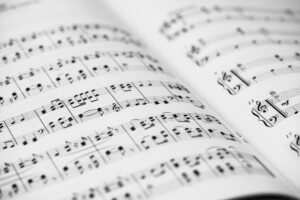 When we hear the word “accident,” we usually picture something bad happening like a car crash or a busted window. So when most people studying music hear the term accidental, they tend to think of something negative. They might picture a wrong note being played or a tune that sounds off. But accidentals in music are nothing like either of these connotations. In fact, accidentals are in so many songs that have been written throughout history, and are necessary, at times, to create the perfect arrangement. Anyone who is taking online music lessons from a professional musician would probably be familiar with the term. Here is what an accidental in music is and why every musician, beginner or professional, needs to know how to use them.
When we hear the word “accident,” we usually picture something bad happening like a car crash or a busted window. So when most people studying music hear the term accidental, they tend to think of something negative. They might picture a wrong note being played or a tune that sounds off. But accidentals in music are nothing like either of these connotations. In fact, accidentals are in so many songs that have been written throughout history, and are necessary, at times, to create the perfect arrangement. Anyone who is taking online music lessons from a professional musician would probably be familiar with the term. Here is what an accidental in music is and why every musician, beginner or professional, needs to know how to use them.
What is an accidental?
In music theory, an accidental is a note or pitch that is not part of the key signature. The note is usually marked with a flat (♭), sharp (♯), or natural (♮) sign. These signs are used to raise or lower a note by a semi-note or a half step. If your child is looking at sheet music, they’ve probably seen these symbols before.
If your child plays the piano, you might look at the keys and think that the accidentals are all the black keys. And they would be if you’re playing in the key of C or A natural minor. But this is not necessarily true for other key signatures your child may play.
Let’s say your child is playing a song in the key of G. The notes that would be used in this key signature would be G, A, B, C, D, and F♯. However, if your child plays an F natural note (F♮)in the key of G, this F♮ would be an accidental because it’s raising the F♯ up a semi-note.
If your child needs help learning the notes on a guitar, talk to his private guitar teacher about learning the notes on a fretboard.
How an accidental appears in music
As mentioned above, accidentals raise a note by a semi-note or half step. Accidentals are often marked by their appropriate symbol. They can also appear in tied notes, that curved line that hovers above or below two notes (or sometimes more than one) to indicate that the notes should be played together.
Accidentals can also appear in doubles in music. Although, seeing double accidentals doesn’t happen very often because a double accidental usually sounds the same as the note in natural. If you see a double accidental, know that the notes will be raised or lowered by two semi-notes instead of one. Many music professionals will tell you that there are no double natural accidentals. However, there can be double flats and double sharps.
Why do accidentals matter?
If your child is just starting to play an instrument, it’s easy and helpful to practice in one key. But more skilled musicians will tell you that playing in one key all the time is boring. Using accidentals adds drama to a song and what makes a song exciting when we hear it. To be clear, no famous composer or songwriter has probably gone into writing a song and thought, “Gee, I need to make sure an accidental note is in this piece somewhere.” Instead, composers and songwriters write music based on what sounds good to them or what feels right for the piece. If you found a song that was in one key all the time, the song would be boring. Well, maybe not The Beatles’ song, “Twist and Shout,” that’s one song among the rare that sounds good and doesn’t have any accidentals in it.
Still need some help?
If you’re still a little confused, we get it. Sometimes it’s easier to learn a concept with a tutor, whether in-person or virtually. Lessons In Your Home hires the best of the best, and all of our instructors are thoroughly vetted. Our teachers will come right to your home for every lesson, plus we offer virtual music lessons, too. However, our online music lessons are being taught by local music teachers with live lessons tailored to your child! Contact us today to learn more.
